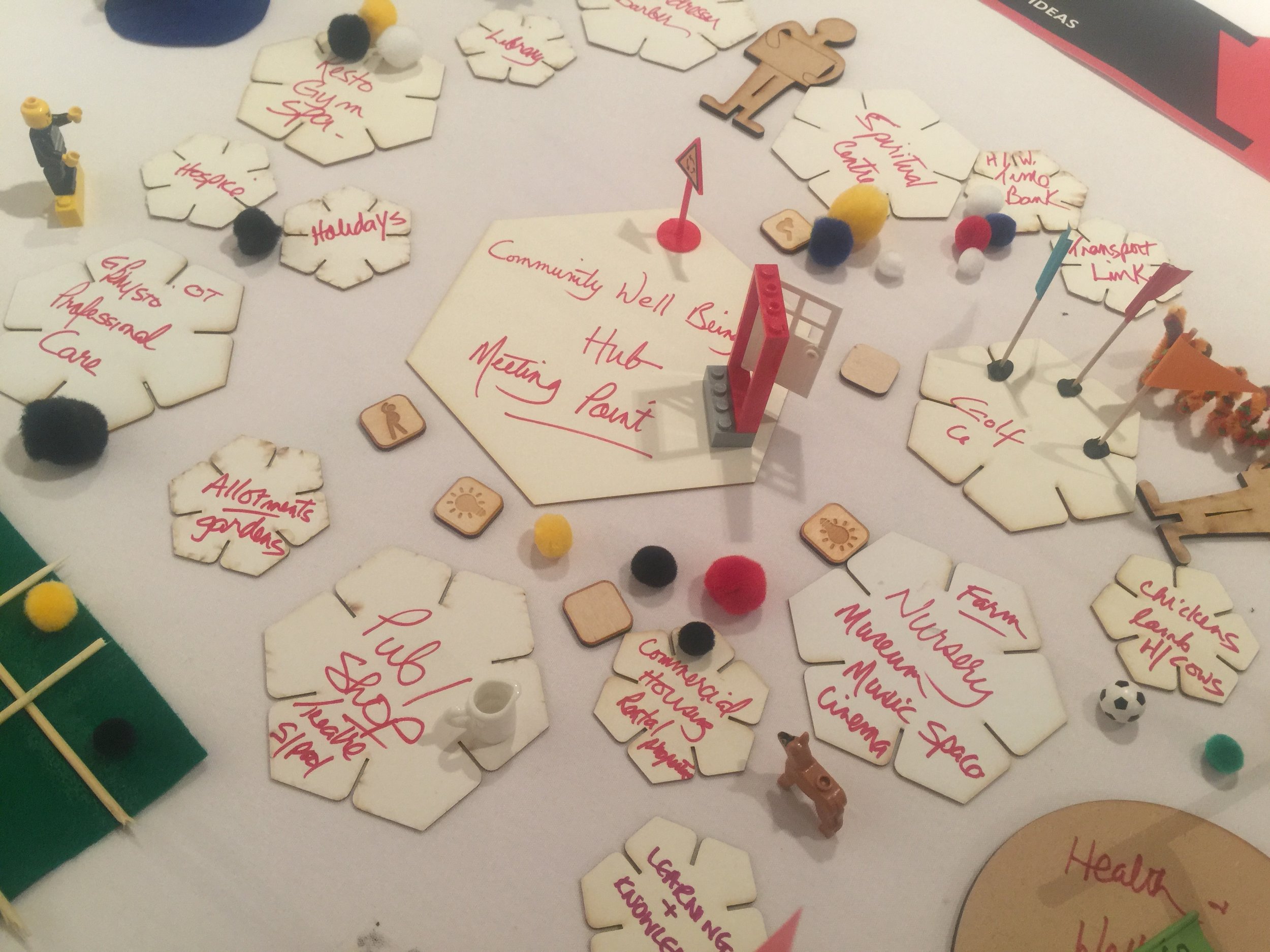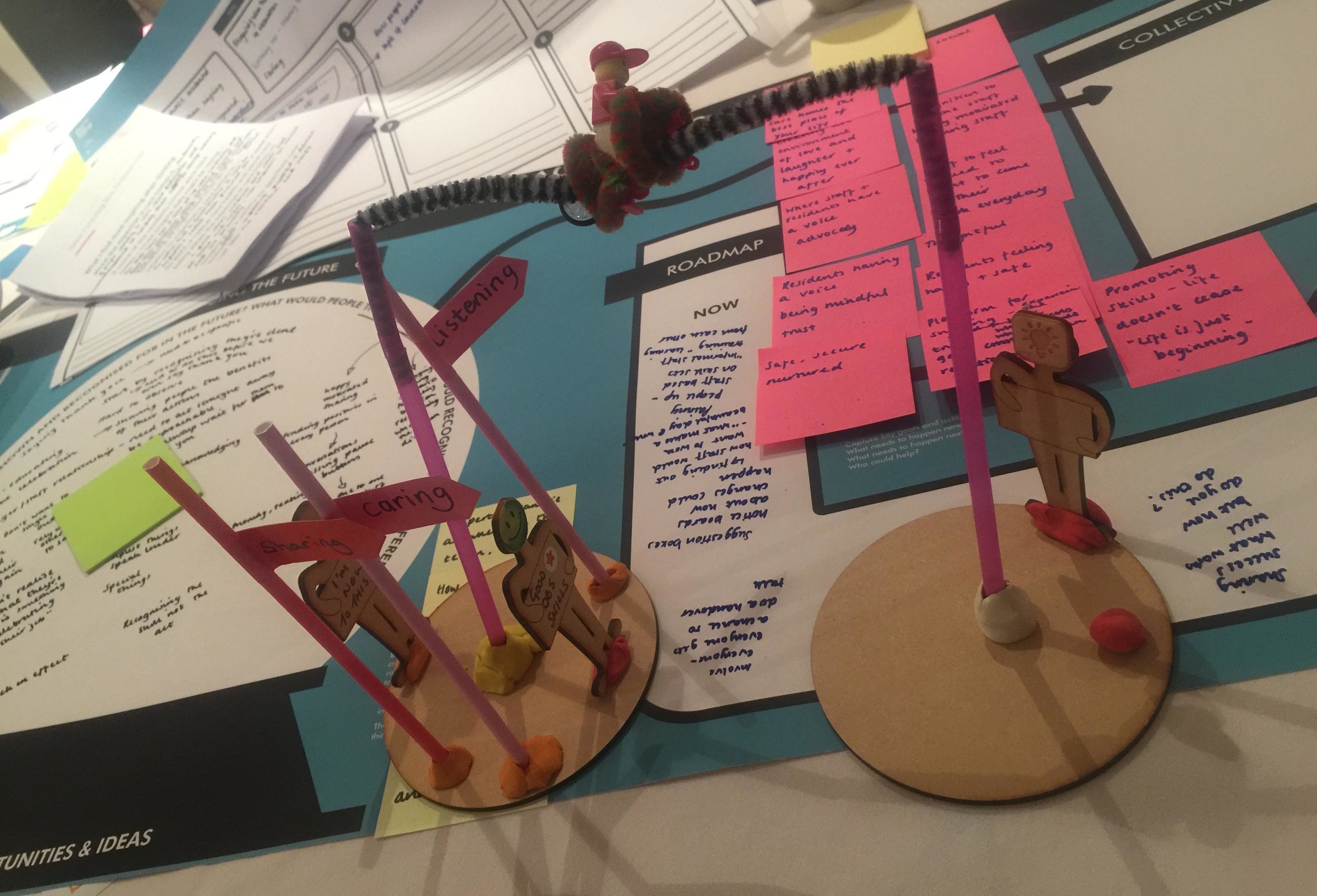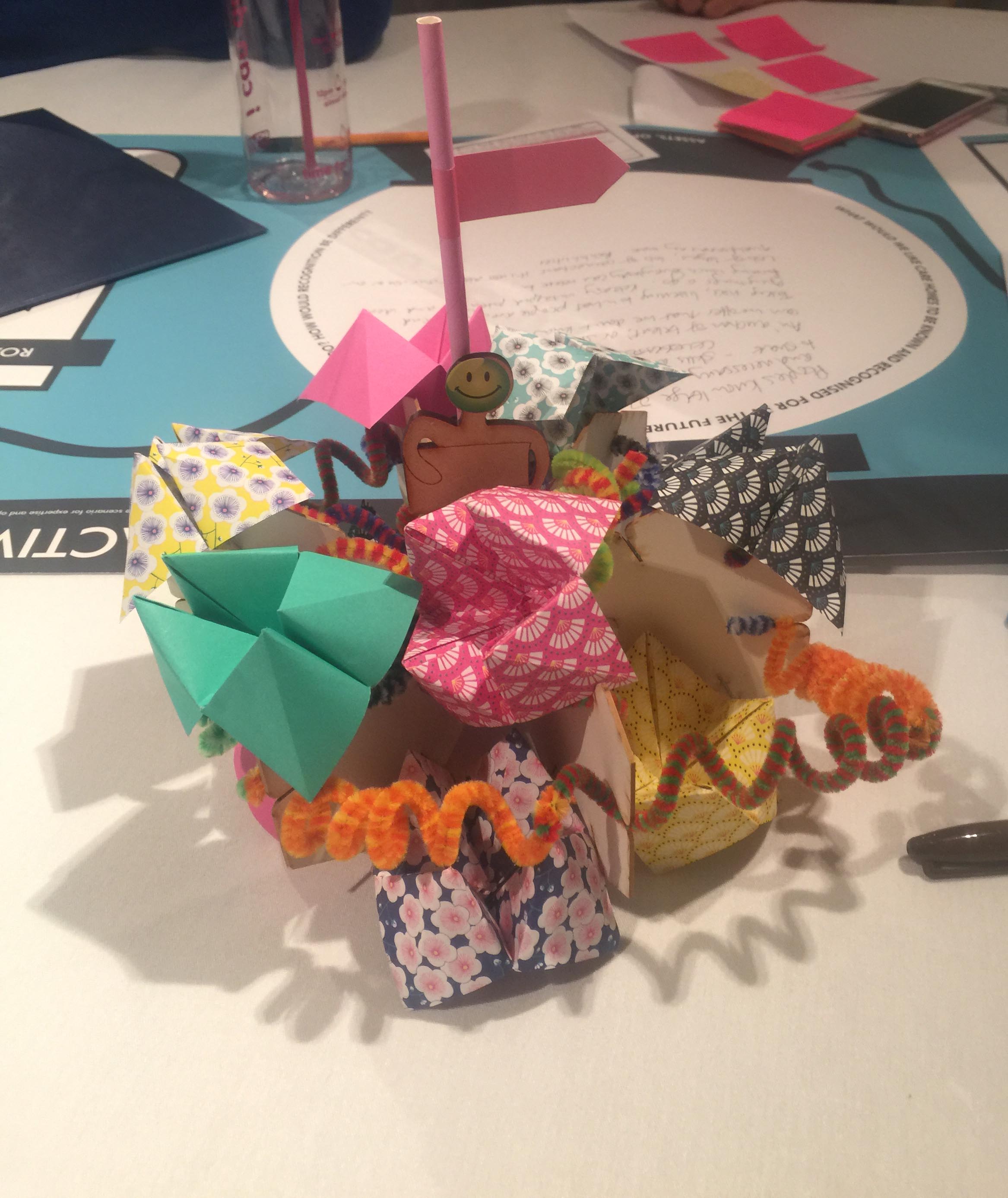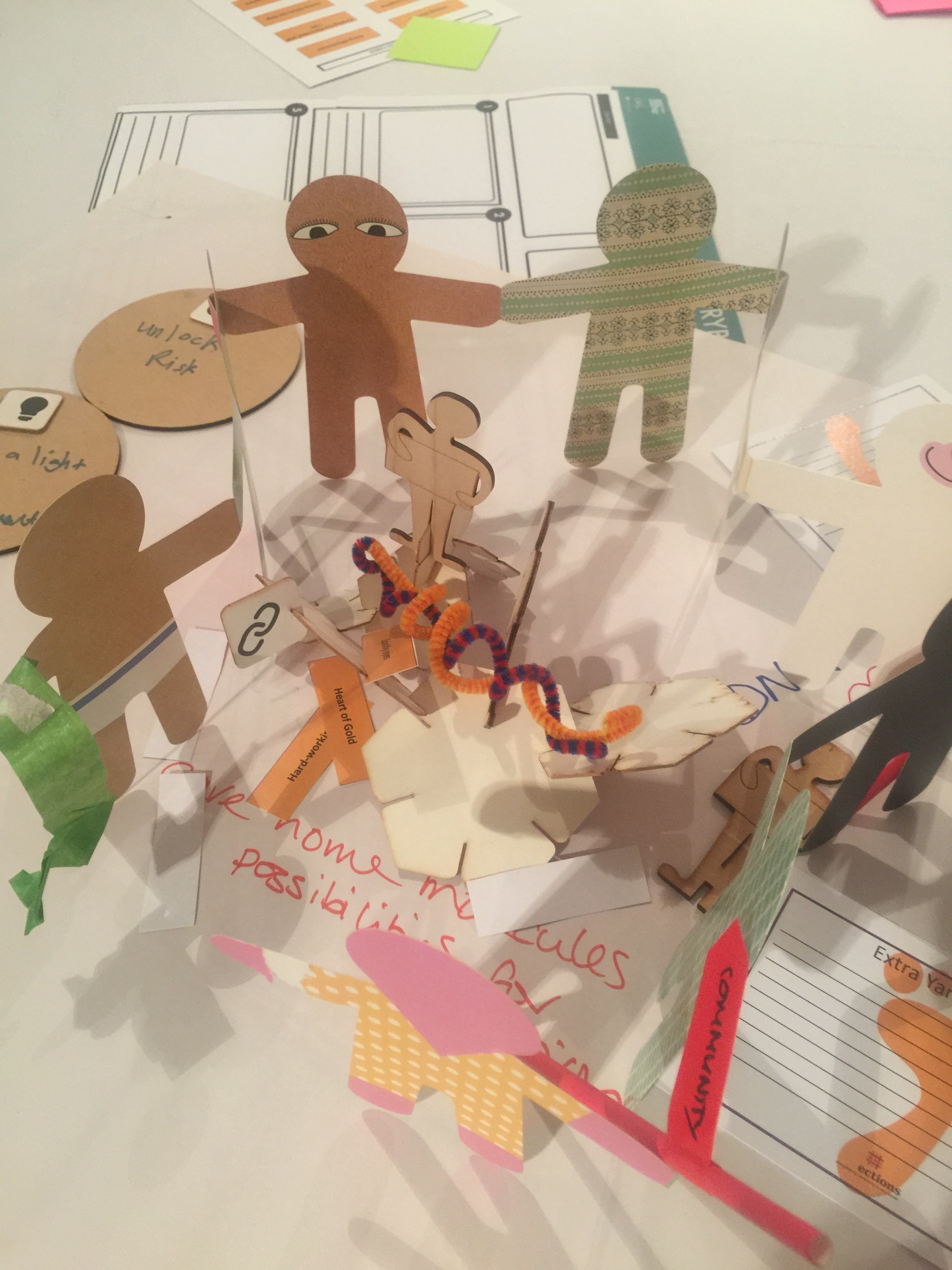Creative exploring care home futures
background
'Creatively exploring care homes futures’ involved a collaboration with the University of the West of Scotland and Scottish Care to explore the image and vision of care homes in the near future. Involving the perspectives of care home providers, staff and residents, this project aimed to ensure that exploration of the future and opportunities to innovate were informed by lived experience. The project brought together the strengths of a design-led approach and Appreciative Inquiry to explore and illustrate dynamic ways of engaging with the breadth of priorities within care homes.
Project aim
Combining the expertise of The Innovation School and the LIFE programme at UWS, the project aimed to create a safe space for participants to share insights and creatively explore care homes in the future, supported by design tools and methods.
The research focussed on three interlinked areas:
Care home as community
Care home experience of the workforce
Care home experience of residents and families
Methodology
The approach employed a range of methods in order to creatively engage participants in the exploration. Each method and form of engagement was designed based on the participant group and context. The emergent nature of the approach began with a project scoping session among the collaborators to create a shared understanding of the context and narrow the focus of the project. The process was iterative in that each activity informed the next.
Question card as part of the pop-up
Pop-Up Engagement
We employed pop-up engagement (Teal and French, 2016) at the annual Care Home conference organised by Scottish Care to engage delegates around the future of care homes. Using the analogy of future news headlines we invited delegates to share a headline for what they would like to see for the future of care homes.
Exploratory and Co-Design Workshops
An exploratory workshop was held at the annual Scottish Care, Care Home conference as part of the interactive ‘insight sessions’. During the workshop visual inquiry was used where participants were invited to select an image card (Roddy et al 2019) and share a story related to care homes. Participants then responded as a group to a provocation which supported conversations around the themes of technology, policy, education, economy, social and community aspects of care homes. A canvas was designed to guide and record the conversation in each group. Groups then shared the outcomes of their conversations.
Four themes emerged from the analysis of the data generated through discussions among the project collaborators, alongside the data collected from the pop-up engagement and the first workshop. These themes were:
Reimagining risk
Sparking curiosity
Recognising expertise
Connections and exchange.
Future CHIT (Care Homes Inquiry Topics) chat briefs on each of these themes were then created by the project team. These themes were then used to inform the design of a second workshop which was held at the LIFE programme’s annual retreat. Members of the LIFE programme were invited to participate which included mainly care home managers. Participants had been given the briefs before the workshop to select which theme they would prefer to explore in depth.
A canvas was created (see example visual below) to guide the group conversations around each theme. The canvas was also a way to capture and record the group conversations and was structured around two key activities: sharing stories and imagining the future. The final part of the day focused on creating a roadmap of actions towards achieving the vision that had been identified in response to the thematic brief. In addition, the participants were asked to visually communicate their future vision through craft materials we provided (see images below).
Credit: Ute Schauberger




Images: building future visions in response to themes
Engaging care home residents and relatives
Engagement with care home residents and relatives involved two days in two different care homes to explore the themes emerging from the project. The morning of each of the two days involved working with care home staff on developing the questions and focus to inform the discussions with the care home residents and relatives in the afternoon. During these discussions creative methods (e.g. co-creation and visual storytelling) were used to help people to articulate their emotions and experiences as well as their hopes and aspirations. An interesting insight that emerged from these discussions was the idea of it being unnecessary to think about creating a new future in care homes if people are very content with the present. The engagement raised questions around how best to involve people in discussions which use people’s own experiences to go on to explore the wider care home context.
findings
An analysis session was organised with participation from all collaborators where data generated from the retreat workshop was clustered thematically in order to produce a summary of key insights, future questions, provocations and recommendations.
Retreat themes findings
#1 Exploring risk in the future of care homes
Risk-taking is already happening positively on a daily basis in care homes. While assessing risk and making decisions about risk is an everyday activity, there is complexity around the way risk can be enabled. The stories of risk shared by participants during the retreat workshop provided examples of overcoming risks by finding solutions and putting additional support in place to create a positive outcome. The examples highlighted the emotionality of risk in relation to both joy and fear, as well as the importance of relationships and trust around making decisions about risk. Questions were posed around advocacy related to capacity for residents to take responsibility for risks and the need to challenge assumptions around how risk is perceived and what do we mean by risk. Participants gave the example of CAPA (Caring about Physical Activity), an initiative run by the Care Inspectorate, as an opportunity where conversations around everyday risk-taking, for example residents mobilising independently, has opened the door for conversations in care homes regarding risk in everyday life.
In considering the future of risk, participants highlighted the need to share stories of positive risk taking and reframe risk around opportunities – ‘why not take risks?’ There was discussion about the value of positive stories being shared with colleagues in other organisations, for example social workers, who traditionally may have been more likely to hear about complex or challenging situations. The findings suggest that positive risk-taking is happening especially where residents are able to articulate for themselves what they want to do and staff seem comfortable in supporting and advocating for residents, however it can be difficult when the person does not have capacity or if the staff members do not feel supported to take risks. From the perspective of care home staff a feeling of other people supporting, helping and looking out for you was raised as being helpful for staff when advocating for residents being supported to take a risk. It was also highlighted through conversations with residents and relatives that a focus or concern about risk is not unique to the health and social care sector, and that people who live and visit care homes may have their own particular perception of what level of risk is appropriate.
Possible avenues for further exploration with care home residents, relatives and staff include:
The concept of risk, when we talk about risk what do we mean?
How different people perceive risk and how this might be influenced by their role/responsibility, personal experience and societal factors.
Enablers of risk and situations when risk-taking is beneficial, particularly in the context of person and relationship-centred care.
#2 Sparking curiosity about care homes
The theme of ‘sparking curiosity’ arose from discussions surrounding the nature of the stories in the public domain about care homes and how these stories tend to be of a dramatic nature. This led to consideration of what we might be seeing and hearing if the stories told were authentic insights into day-to-day life in care homes.
The ‘ordinary’ and everyday actions of staff already make a difference to care home living. Participants were surprised how the small, simple things (e.g., the smell of baking bread with residents) were able to trigger a positive reaction in people experiencing the care home. The value of non-verbal communication expertise of the staff (e.g. touch) and growing relationships between residents were described as ways these small moments of joy happen. Questions were raised as to the ways in which care homes could be seen as places where small moments of joy happen regularly.
Another key discussion point related to the ‘hospital’ or ‘hotel’ expectations that people can often have around the services that are provided within the care home which can lead to passive involvement and contribution. Changing these expectations and communicating the value of the everyday experience led participants to explore how this could be achieved.
One group at the My Home Life retreat exploratory workshop came up with a future scenario where a care home was a vital part of the community – an intergenerational wellbeing hub – that would support spontaneous engagements and interactions for people living with dementia and be a place for personal development. The idea aimed to recapture a sense of community without falsely creating it, seeking to ‘normalise’ care homes as part of the daily life within the community. The multidisciplinary hub aimed to break down barriers about the preconceptions of care homes, overcoming stigma by introducing people to care homes in different ways through the other services that may be offered that attract different community groups.
Relatives spoke about how having first-hand experience of care home life, through previous professional experience in care home, positively influenced their feelings about their own family member moving to a care home. Existing initiatives which create connections between care homes and nurseries, schools and colleges were celebrated for the joy they bring residents, and the relationships that develop through bringing these groups together. There was the hope that upcoming generations who have had early experiences of everyday care home life and hence the way they think, feel and talk with others about care homes will be reflective of these experiences.
There was recognition within the collaborators discussions on this theme that there are other voices which would have a valuable contribution to make to our understanding of ‘authentic insights’ and ‘sparking curiosity’. Further discussion with those who live and work in care homes, along with people who work in media, community groups, education etc. were felt to open up the potential for nuanced understanding of our decision-making and motivation around the types of stories that are shared about care homes, and what possibilities there are in terms of the most appropriate ways in which to share these stories. Future exploration should also consider how we ask about a new future when people are content with the present.
#3 Recognising expertise and opportunity
Recognising expertise and opportunity was spoken about by participants as giving due regard for the vast amount of experience, skills, talents and qualities that belong to those who live, work and visit care homes. To see care homes as being places of opportunity is to recognise that rather than moving to a care home signalling the end of someone’s life or career, that it can signify the opening up of possibilities for sharing existing expertise and discovering new opportunities.
Enabling staff to recognise their skills and expertise is challenging and requires a level of confidence in staff to develop this awareness. Often staff hold in their ‘heads’ the knowledge and experience they have developed about residents and it is difficult for staff to find ways to share and teach this knowledge. Expertise was hard for participants to describe and the expertise that was discussed and celebrated were the small moments/acts of kindness where people were doing ‘everyday’ acts that really made a difference and impact to the lives of residents, families and other staff. The types of actions were very implicit and natural that people may not consider as things that need to be celebrated. Participants spoke of highlighting these types of things to staff who would shrug this off as ‘just my job’. However, participants felt there was a need to value the social expertise of staff even suggesting that people should be employed because they are social experts/beings rather than have explicit qualifications in social care. The need to focus less on qualification as expertise and skill and the formalities/explicit side of care - people weren’t talking about expertise in this way, the value was very much in the ‘caring’, valuing the ‘how’ not the ‘what’. Participants also highlighted the balancing act of ‘whole team recognition’ in order to reward and celebrate expertise and skill but not single out examples, ensuring everyone feels valued and motivated. The difficult task is in how to give recognition to this type of expertise and make staff and others aware.
Creating a platform for how to share knowledge and expertise was identified as way to learn from each other and share this among staff, residents and families. Giving presence and visibility to expertise and opportunity for people who are not involved in the care home context would help to overcome myths and assumptions of what people do in care homes. Having time to reflect and have conversations with others about people’s strengths was viewed as being core to residents and staff being able to recognise and name the particular elements of insight, wisdom and gifts they bring to the care home community.
Ideas for future ways to communicate expertise and skills were around training in observation and awareness (being able to ‘witness’), buddying with someone else (more and less experienced) but also new residents being paired up with others who have similar interests, a notice board to make tangible and visible the types of skills and expertise, and having an auction of skills and talents.
There is scope to further enhance our understanding and appreciation of all the types of expertise that exist within care homes (e.g. creating a nice space for others that they can’t do for themselves) and also perspectives from residents, relatives and others visiting care homes who might highlight other expertise that exists in care homes. Related to this is the need to explore how expertise is assessed, challenging current systems of performance and assessment in care homes. Given the increasing development and use of technology across the care sector, another area of exploration related to expertise would be to explore skills which are impossible to replace by technology. This would help to further define and emphasise social and interpersonal expertise in care homes which is currently underestimated and simply part of the ‘everyday’.
#4 Exploring connections and exchange
The group found the brief quite challenging given the overlap and relation to other themes and it was also the most difficult brief to frame. Discussion focused on the ‘reciprocity’ opportunity in care homes through creating connections ‘out’ and ‘in’ – retaining existing connections to the community and making new ones. The group highlighted the need to find out what connections would be important and meaningful (not tokenistic). Questions were posed around the language used in the context of care homes and also how we might describe the idea of ‘mutual investment’. Normalising care homes in the community was seen as a way to reduce the fear of growing older which also helps to move the conversation away from the financial burden of care homes in society. The ideas shared by participants related to the ‘housing’ element of care homes and the fact it can be used for other community activities and intergenerational interactions.
It was considered to be valuable to consider which other people and groups may have insights and ideas around connections and exchange. This would include who might be involved in ‘exchange’ in the context of care homes, what they might exchange and how this would work in practice. The theme initially began as a way to explore funding models of care homes and therefore it is suggested that future work consider returning to this to explore further.
Recurring themes
‘Demystifying’, language and perceptions: the need to ‘demystify’ care homes and their residents, both in relation to care home life and the perceptions held by others was a prominent discussion point across the themes. The language used to communicate living and working in a care home can often exacerbate stigma and a fear of growing older. The language used to describe things like ‘risk’ and ‘expertise’ can also change the way people view these topics/situations, often leading to negative experiences, and to disregarding staff expertise.
Recognising the everyday: the need to acknowledge the ‘ordinary’, everyday living and working of care homes recurred across the themes, particularly in relation to sparking curiosity about care homes and recognising expertise. Recognising the ‘ordinary’ is difficult, yet leads to significant positive experience and impact for residents, visitors, and staff. Staff recognising the value and significance of what they do, that then moves the thinking from ‘we are just doing our job’, was celebrated as a hope for the future.
Sharing stories and experiences: the need to share stories and experiences related to all of the themes. However, although this is a key action that was highlighted by participants, there remains a need to find ways to share stories to develop further inquiry and possible future actions.
Areas for further consideration
A number of key recommendations have emerged based on the findings of the project:
Engaging the wider care home sector: This project engaged a very small portion of the care home sector and participation largely provided a management perspective. There is a need to engage the wider care home sector using the tools developed as a result of this project to gain a wider understanding of the themes explored, as well as gain different insights and ideas in response.
Engaging the ‘unusual suspects’: Sparking curiosity about care homes and changing public perceptions of care homes needs a national conversation. We need to engage with wider groups and members of the public to generate questions related to this theme and gain understanding of how best to spark curiosity about care homes. This would also develop understanding around how care homes are perceived, whilst ‘normalising’ and creating awareness about care homes.
Moving beyond improvement: The findings highlight the everyday practices of care homes and sharing of good practice that is happening across the sector. However, there is a need to take this beyond considering how more of this can be done and how this can be shared, towards being able to critically reflect on good practice to understand where opportunities for innovation in this context lie. Aligned to this, in terms of identifying opportunities, there is a need to tap in to potential and create the space for innovation to remove the fear of trying new things and learning from doing. Within this there may be opportunities to recognise the need for policy-level discussions, for example around care home funding models, pay and conditions for people who work in care homes, whilst also acknowledging the power that lies in the hands of citizens to create a future for care homes that reflects the best of the present and is continually open to learning more about people’s aspirations for the future.
Toolkit: Care home conversations
A toolkit containing a set of future provocation question cards, a series of future CHIT chat briefs and a conversation canvas was created as an output to allow continued conversation and further engagement by Scottish Care. The toolkit aims to support Scottish Care to take forward the recommendations highlighted above to engage a wider, national audience in the future of care homes.
Downloadable link to future question cards (A5 size)
Future CHIT (Care Homes Inquiry Topics) chat briefs (A4 size) providing ideas for themes and topics
Downloadable link to future conversation canvas (1840 x 565 mm)
For more information contact:
Dr Tara French | t.french@gsa.ac.uk
Ute Schauberger | u.schauberger@gsa.ac.uk
Yoni Lefevre | y.lefevre@gsa.ac.uk
Prof. Belinda Dewar | belinda.dewar@uws.ac.uk
Dr. Edel Roddy | edel.roddy@uws.ac.uk
In collaboration with:










